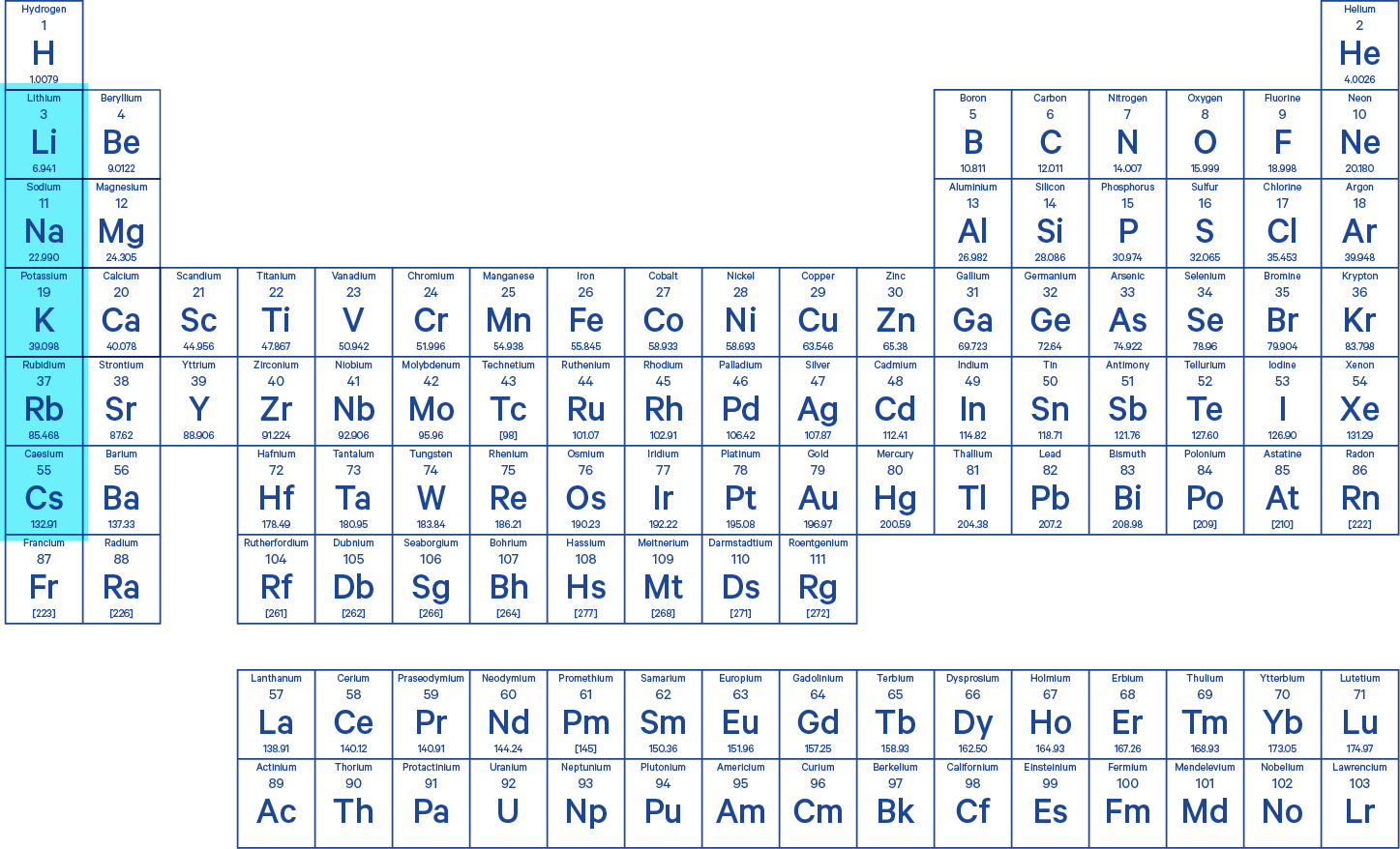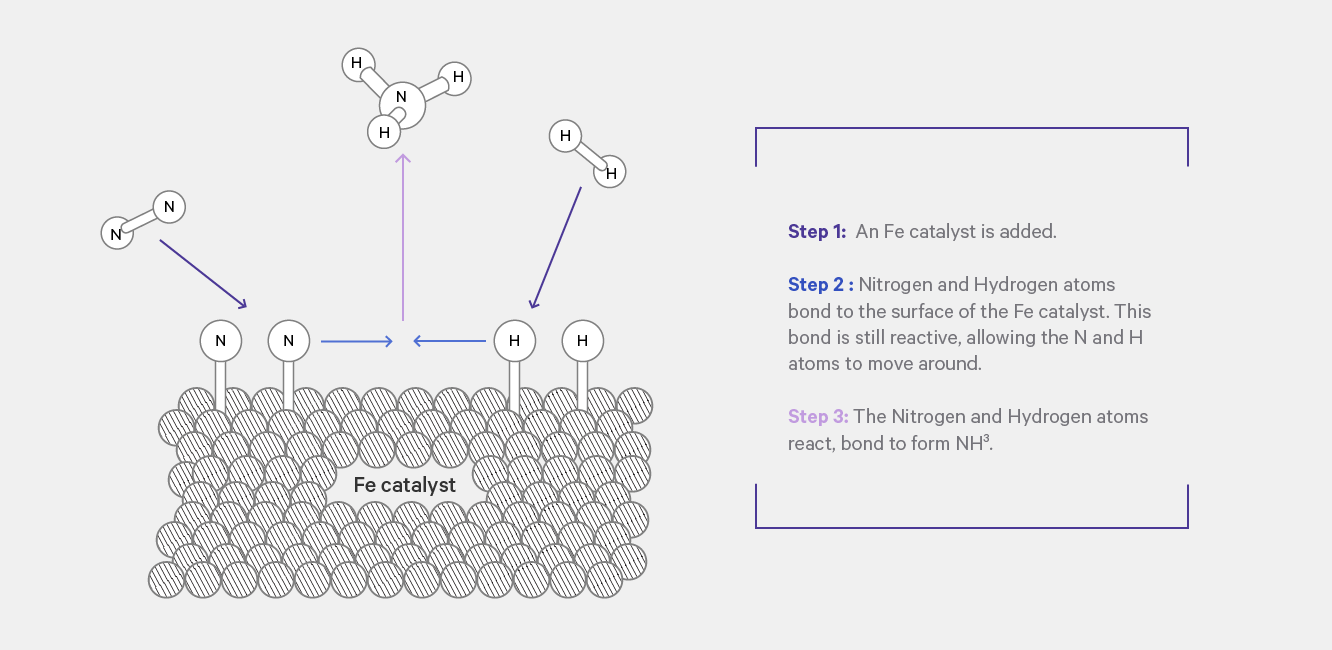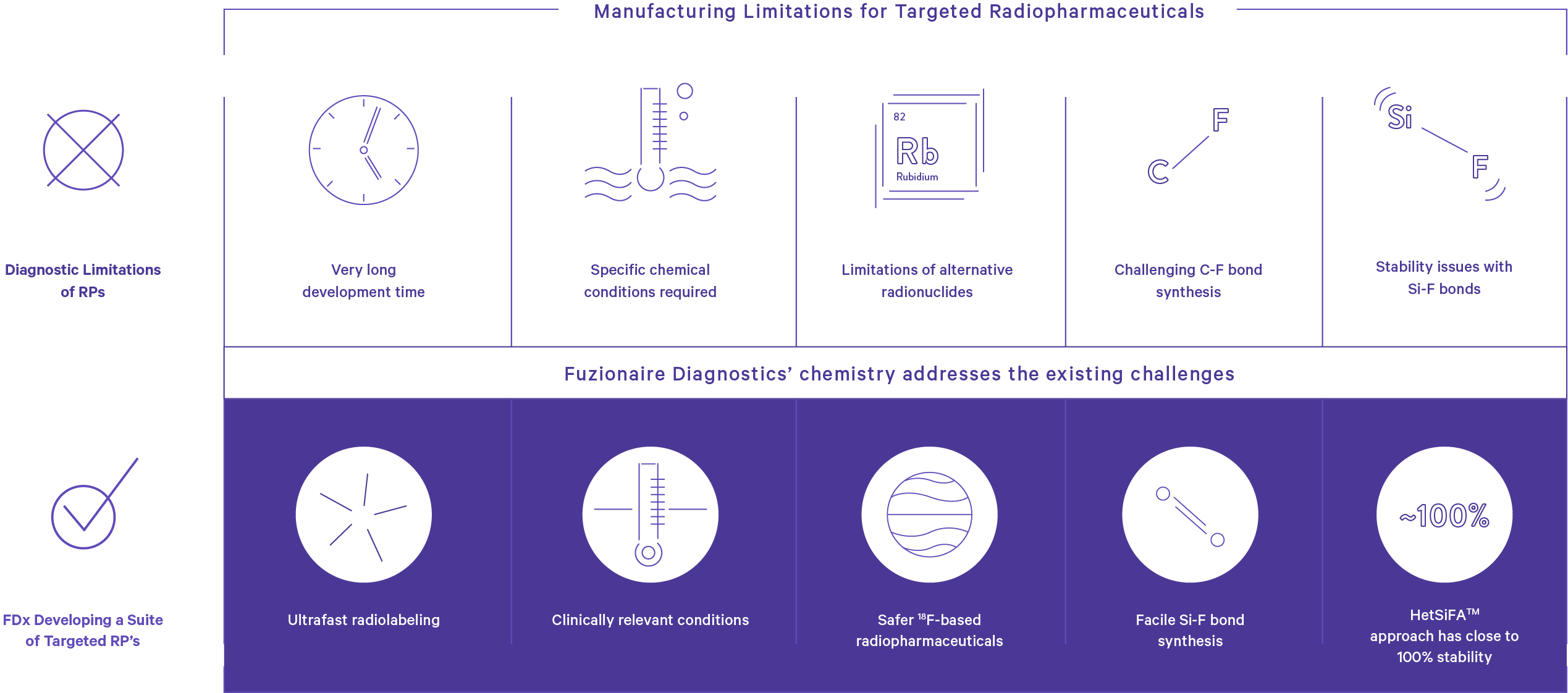
Today, we are launching Fuzionaire Diagnostics.
Technological progress often comes from incremental improvements to existing technologies, rather than major evolutionary leaps. But occasionally there is a truly fundamental advance that improves the entire foundation on which we are building. This is the type of leap we are announcing today.
Fuzionaire Diagnostics (“Fuzionaire Dx”) is announcing a major medical chemistry advance that enables earlier detection and diagnosis of diseases, more precise monitoring of disease progression, and even more targeted disease treatment.
A Medical Diagnosis Breakthrough
Our breakthrough is based on a patented new radiopharmaceutical platform that enables positron emission tomography (PET) scan medical imaging systems to precisely see the presence and location of virtually any disease, by targeting individual cells, anywhere in the body.
Many serious diseases such as cancer are actually more easily curable if detected early — but they are often not detected until later in their progression. But Fuzionaire Dx’s technology can, for example, detect the signs and locations of early stage cancers, at the cellular level, making it much easier to target the cells that need to be treated, before the disease has spread.
But this is just the beginning of what this technology enables. As well as radically improving the early detection and diagnosis of diseases, Fuzionaire Dx’s technology also can help to monitor how diseases progress, and how well various treatments are working.
Our technology can even be used in drug development to test new pharmaceutical candidates earlier and more precisely, reducing the costs of drug trials and identifying potential problems at the preliminary stages of drug discovery.
We also believe that our platform may be eventually used to develop targeted theranostics, which combine precision diagnosis with precision targeted therapy, in the future.
But to understand how our technology works and why it’s such a big advance, we need to go back in time to the research at the roots of our discovery — a major breakthrough in chemistry, at Caltech.
Our Founding Story
Our story begins many years ago, with Anton Toutov, our co-founder and Chief Scientist, and his doctoral research in organic chemistry.
In the course of earning his PhD from Caltech, Anton worked in the laboratory of Chemistry Nobel Laureate, Prof. Robert Grubbs.
It was in Grubbs’ lab that Anton made a revolutionary discovery in chemistry: a new form of catalysis, using alkali metals (highlighted in the periodic table below) such as potassium and sodium instead of precious metals, to make and break chemical bonds between the most abundant and important elements on Earth, including C, Si, H, O, N, and S.

Anton immediately understood the potential of what he discovered to revolutionize a number of industries.
I met Anton through our co-founder Nick Slavin, and immediately knew I had to become a part of this project.
I have been involved at the ground-level of a number of world-changing technologies, from founding one of the first Web companies, EarthWeb, in 1994 to working on the foundational AI technology at SRI that would later lead to the development of SIRI, and new breakthroughs in augmented reality. But compared to everything I have worked on, Anton’s breakthrough is by far the most fundamental and world-shifting technology I have ever been a part of.
Anton, Nick and I co-founded a core chemistry innovation and IP holding company, called Fuzionaire, several years ago to take Anton’s research to market across the many industries it will affect. After years of stealth R&D, we are announcing our first go-to-market spin-out, Fuzionaire Diagnostics.
Fuzionaire’s core technology is a patented set of discoveries that enable an entirely new branch of catalysis, based on Earth-abundant metals like potassium and sodium, instead of precious metals.
This new form of catalysis enables otherwise energy- and material-intensive chemical processes to occur under conditions of ambient temperature and pressure, at less cost, and with substantially less waste and potential environmental harm.
Fuzionaire makes catalysis up to 10,000X less costly than state-of-the-art precious metal catalysis. More importantly however is the fact that catalysis is so fundamental to industry, technology and in fact the progress of civilization. In fact, Fuzionaire’s core catalysis platform has the potential to affect and improve the majority of manufactured products in the world.
This might sound too good to be true. But the potential here is so great, and the team is so qualified, that everyone we talk to, who does their diligence, agrees that what we have here is a truly major, “once-in-fifty-years” technological advance.
It also helps that our process is well-documented in peer-reviewed papers and in experiments conducted by third party academic research labs.
A list of selected papers can be found here.
In addition, we are conducting ongoing trials ourselves, and the results are better than anything we could have hoped. But the most important point is that the world needs what this technology makes possible: It can truly help to deliver on the promise of the old slogan, “better living through chemistry.” More than anything, that truth is driving us.
Fuzionaire’s core chemistry has applications in new medical therapies, energy, materials, consumer electronics — you name it. And because there are so many industries that Fuzionaire’s core IP will ultimately affect, we have decided to spin out a series of focused ventures, based on the core platform but with further innovation and IP for particular industries and markets.
And the best place to start is with saving lives, which is why we decided to focus our first spinout company on medicine, which led to the formation of Fuzionaire Diagnostics (“FDx”), and our announcement today.
We are fortunate to also have an incredible group of colleagues joining us on the Fuzionaire Dx team – including luminaries at some of the country’s top institutions: Fred Chin, PhD, at Stanford University School of Medicine; Jason Lewis, PhD, at Memorial Sloan Kettering Cancer Center; Dennis Liotta, PhD, at Emory University; Jennifer Murphy, PhD, and Michael Phelps, PhD, at UCLA; Douglas Scherr, MD, at Weill Medical College of Cornell University; and Kristin Swanson, PhD, at Mayo Clinic.
We’re honored to have such an extraordinarily accomplished team as we bring our radiopharmaceutical platform to market. Dr. Lewis, for example, is former President of the World Molecular Imaging Society. Dr. Liotta is co-inventor of leading HIV drug Emtriva, used by 94% of HIV-positive patients in the US. Dr. Phelps is the inventor of positron emission tomography and the PET scanner.
What you Missed in Chemistry Class May Save your Life
So let’s dive into how we actually apply Fuzionaire’s core technology to medicine, in our first spinout, Fuzionaire Diagnostics.
As explained above, our technology is a fundamental advance in catalysis. But what is catalysis exactly?
In the simplest terms, catalysis is a chemical process that makes an otherwise impossible or difficult chemical transformation occur more easily, by helping the reaction overcome energy barriers. In fact the energy it takes to make or break certain chemical bonds is often too high to happen without catalysis.
Another way to think of catalysis is that it is an alternate route for causing a particular chemical process to occur. Catalysts provide a new, lower energy path for a chemical reaction to follow than if the catalyst were not present.
Today, 90% of all commercially produced products involve catalysts at some stage of their manufacturing.
About 19% of all Nobel Prizes awarded in Chemistry have been for discoveries related to catalysis. In fact the history of technological development and of civilization is very connected to the history of advances in catalysis.
Let’s look at a popular example of how catalysis works, in a well-known chemical reaction:
N2 + 3 H2 → 2 NH3 (ΔH = −92.4 kJ·mol−1)
In this process, nitrogen and hydrogen gas react to form ammonia, using an iron-based catalyst. The challenge with this process is that it requires increased pressure to yield more ammonia.
At room temperature and pressure there is not much ammonia generated. However, conducting the reaction at 450 oC and 200 atm yields much more ammonia.

This reaction is known as the Haber-Bosch process, which is one of the most important inventions of our modern world.
It is responsible for producing 500 million tons of nitrogen-based fertilizer each year, which feeds almost half of the world’s population.
Three to five percent of the world’s natural gas production is consumed in the Haber-Bosch process (around 1-2% of the world’s annual energy supply).
As fundamental as catalysis is to our modern society, it is inefficient, expensive, and dirty, requiring high temperatures and pressures, and often also needs precious metal catalysts, which are even more expensive and environmentally toxic.
A Giant Leap for Disease Diagnosis
Fuzionaire Diagnostics is starting by launching a patented new radiopharmaceutical drug platform for diagnosing diseases, that is designed to be used with PET scan medical imaging systems.
What is a radiopharmaceutical? It’s a molecule that generates very low levels of radiation that can be detected in medical imaging systems. (With the latest technology, the radiation is comparable to that which a passenger on a roundtrip flight from LA to London would receive.)
Typically this is done by attaching a short-lived radioactive isotope (in this case, fluorine-18) to a molecule that is injected into the patient who then undergoes a PET scan.
This radiolabeled molecule is specially designed to go to a certain location where there are particular molecular features to which it bonds (e.g., the surface of a cancer cell in the colon or an aggregation of amyloid plaques in an Alzheimer’s brain), taking the positron-emitting fluorine-18 radioisotope with it.
The resulting PET scan allows a healthcare worker to visualize the location of the radiolabeled molecule in the body (because it accumulates only in a specific region and then that location is “lit up” in the PET scan), which precisely indicates the location of diseased tissue.
In other words, Fuzionaire Diagnostics’ platform allows for a huge leap forward in targeted and personalized medicine, starting with higher precision imaging of diseases, and earlier diagnosis. But that’s really only the beginning of what this enables.

We chose to start with radiopharmaceuticals as our go-to-market for a few strategic reasons:
The market is ready. We’ve been in conversation with several major potential partners in the healthcare space, and it’s clear that there is a serious need for the new capabilities of the radiolabeling platform we’re bringing to market. This is echoed by the leading academics and researchers in the space, including our advisor Michael Phelps, the inventor of PET.
Radically expands what PET scans can image. The potential impact is profound. We’ve made it possible, for the first time, to rapidly, efficiently, and in a clinically-suitable fashion produce a broad range of 18F radiopharmaceuticals based on a single disease-agnostic platform.
This radically expands the range of diseases and conditions that PET scans can be used to image. Using our patented radiopharmaceutical platform, researchers and clinicians can detect, localize, diagnose, and monitor more biological processes and more diseases, earlier, and with unprecedented precision.
Potential to improve drug discovery. Our radiopharmaceutical platform is also immediately useful to drug discovery, as researchers can use it to gain unique pharmacokinetic information for new drug candidates and quantification of drug properties in vivo.
Our radiolabeling platform will make PET a ubiquitous, essential, and cost-effective tool that improves decision-making, and increases returns on R&D investment throughout virtually all stages of the drug development process.
Potential to bridge diagnosis and treatment. While we’re starting with diagnostics, we can easily imagine a future of theranostics as well, where instead of only delivering a radioactive material we can also deliver medicine directly to the cells that need it, using the same core chemistry platform.
For example, if you could detect the signs of a particular cancer early enough, you can cure it much more easily, without the race against time and battle against the cancer itself.
If you can change the approach to cancer from stopping the cancer, to simply just wiping out a tiny number of precisely targeted early cells, the cancer doesn’t have a chance to develop into a serious disease.
This can also be used to improve the treatment of later-stage diseases, for example by delivering a chemotherapy drug along with an imaging agent only to cells that have the disease, rather than indiscriminately killing or damaging healthy tissues as well.
This can greatly reduce side-effects and improve the efficacy of therapies not just for cancer, but for many other medical conditions.
What’s Next?
Right now, we are focusing on partnering with leading institutions using PET to study and treat challenging diseases, like neurological diseases and cancer, that have been notoriously difficult to localize and diagnose. These institutions are hungry for solutions to improve the medical imaging process, and we are in lockstep with their own research on biomarkers.
But our moonshot goal is the early diagnosis of every disease, in one platform.
This is not an incremental improvement, but rather a fundamental advance in the way we are improving and saving lives.
It’s an ambitious vision and we are excited to make the leap.
Dig Deeper
For more information about Fuzionaire Diagnostics, visit fuzionairedx.com.
To explore more about Fuzionaire’s breakthrough chemistry, links to journal articles, a short film, and other media can be found here.
A list of selected papers can be found here.